(Cross-posted from Daily Kos)
Kentucky is a state similar to West Virginia – it’s one where Hillary Clinton has focused a great deal of attention and is likely to win by one of her widest margins over Barack Obama. While she and Bill Clinton have campaigned vigorously in the state, Obama has only held one rally in the state (last week in Louisville) and doesn’t appear to be returning before Tuesday’s primary. Like West Virginia, the state (and the Democrats in particular) are rural, working-class white voters who have favored Clinton. Throw in the fact that a good swath of Kentucky, particularly the eastern portion of the state, lies in Appalachia, and you have the makings of another rough election night ahead for Obama. Luckily for him, Oregon is also voting the same night – a state which he will almost certainly win – and will therefore counterbalance the negative results here.
Follow me below the fold for a district-by-district analysis of the likely results on Tuesday…
Kentucky (May 20th primary, 51 pledged delegates)
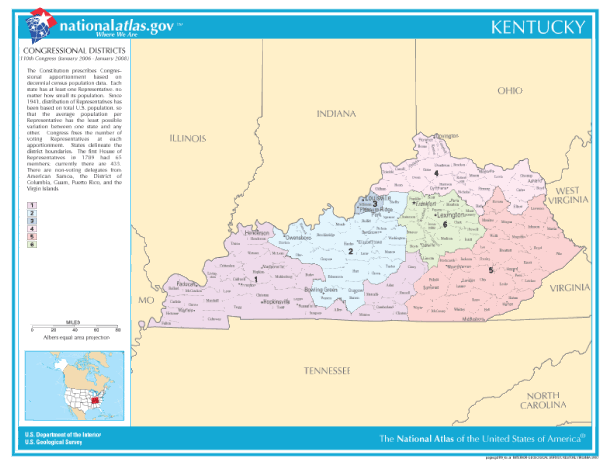
Kentucky is one of the poorest states in the country (it is 46th in the nation), and its demographics (over 91% white) make it such that it’s a state where Clinton will perform very well. As has been the Clinton campaign’s modus operandi in the post-February contests, Bill Clinton has been making several stops a day in rural areas of the state. Although Governor Steve Beshear is uncommitted, both Kentucky Democrats in Congress – Rep. John Yarmuth of KY-03 and Rep. Ben Chandler of KY-06 – have endorsed Obama, along with Lt. Governor Daniel Mongiardo.
Despite these endorsements, one can pretty much venture a guess that Clinton will win the state with margins slightly below, if not close to, those that she won West Virginia with. Although the Obama ground game has undoubtedly been helping out, the polling averages have shown Clinton to be holding somewhere upwards of a 30-point lead. How will this translate to the congressional districts? Let’s take a look.
KY-01: 5 delegates
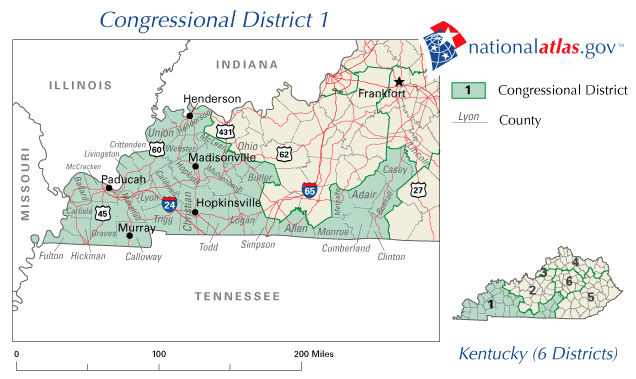
This is one of the most rural districts in the state (CD-05 is the only one that has more of its population in rural areas); it’s also the second-poorest in terms of median household income (again, CD-05 is lower) and has a white population greater than 90%. Clinton could possibly break the 70% mark needed to get a 4-1 split in delegates, but it’s a tough call. The southern counties in Indiana that border the district voted for Clinton, but by nowhere near the margins needed to get an extra delegate. However, the northwestern counties of Tennessee, which voted way back on February 5th, show that Clinton could break 70%. Demographically, IN-08 (which contains those southern Indiana counties) is racially more like the district, but it is wealthier and more urban than TN-08 (which has the northwestern Tennessee counties), which is closer to the district in terms of the urban/rural split and in household income.
Given that overall, the district resembles TN-08 more – but with less African-Americans – I think that Clinton will pick up the 70% needed to earn a 4-1 split.
Allocation of CD-01 delegates
Hillary Clinton: 4 pledged delegates
Barack Obama: 1 pledged delegate
KY-02: 5 delegates

This district has a similar racial makeup to CD-01, but it’s a bit wealthier. Furthermore, with the college town of Bowling Green – a place where Obama should perform reasonably well – he should be able to prevent Clinton from taking a 4-1 split from this district. While Clinton did get over 70% in a few of the bordering counties in Indiana, I don’t think she will be able to perform that well throughout the entire district.
Allocation of CD-02 delegates
Hillary Clinton: 3 pledged delegates
Barack Obama: 2 pledged delegates
KY-03: 8 delegates
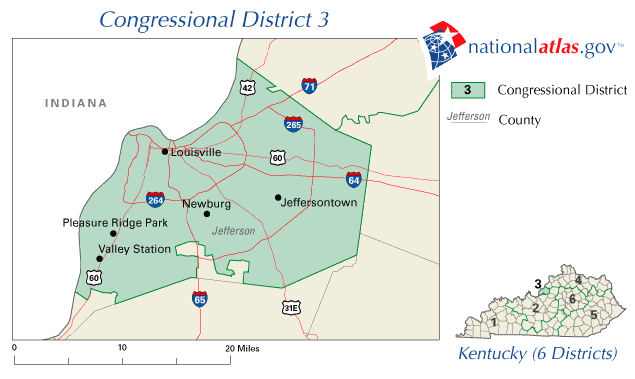
The most urban district in the state, it elected freshman Rep. Yarmuth in the 2006 midterm elections. It also has a sizable African-American population (almost 20%) that should bode well for Obama’s chances. If he can pull a good amount of white support in the primaries, he may be able to get more than the 56.25% needed for a 5-3 split in his favor. However, I don’t think he’ll be able to do so, and the delegates will be evenly split in the district. Clinton may even pull a majority of the popular vote, but I don’t think she will come anywhere close to possibly earning the extra delegate.
Allocation of CD-03 delegates
Hillary Clinton: 4 pledged delegates
Barack Obama: 4 pledged delegates
KY-04: 5 delegates
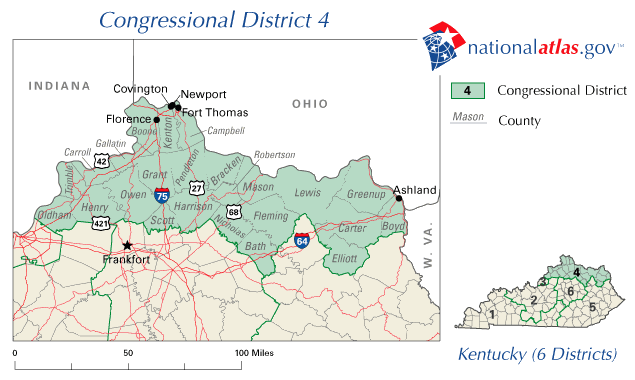
While this district borders counties in Ohio where Clinton performs extremely well (she got over 70% in the rural counties east of Cincinnati), I think Obama will be able to hold Clinton to a 3-2 split because he’ll perform well in the Cincinnati suburbs in the district. It’s also the wealthiest district in the state, and Obama tends to perform better in wealthier districts. Look at Obama’s performance in IN-05 (which he gained a majority of the popular vote) as an example. That being said, I don’t think he will win a majority of the popular vote here to earn the extra delegate – but Clinton won’t come close to the 70% barrier.
Allocation of CD-04 delegates
Hillary Clinton: 3 pledged delegates
Barack Obama: 2 pledged delegates
KY-05: 5 delegates

Clinton will perform extremely well in this district. Aside from the empirical evidence that racial factors will work against Obama, this district falls squarely into Appalachia. It also borders parts of Virginia and West Virginia where Obama performed exceptionally poorly. Clinton will easily win a 4-1 split in the district, but it will take a miracle for her to push Obama below the 15% viability threshold and take all of the delegates.
Allocation of CD-05 delegates
Hillary Clinton: 4 pledged delegates
Barack Obama: 1 pledged delegate
KY-06: 6 delegates
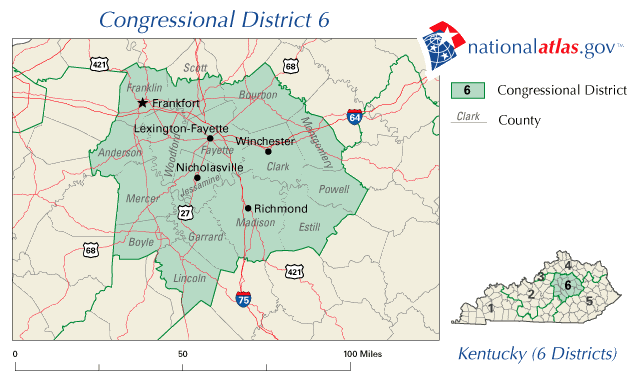
Ben Chandler’s district is likely to go for Clinton by a reasonably wide margin, despite the urban nature of the district. Unlike CD-03, there isn’t a large enough African-American population to help boost Obama’s chances (only 8.3% of the district), and given the eastern location of the district, Obama may face an ‘Appalachian’ problem with the white voters in the district. Despite Chandler’s support, Clinton will probably break the 58.5% needed to earn a 4-2 delegate split.
Allocation of CD-06 delegates
Hillary Clinton: 4 pledged delegates
Barack Obama: 2 pledged delegates
At-Large Delegates (11 delegates) and Pledged PLEO Delegates (6 delegates)
The polling average that I referenced above has Clinton up by approximately a 36-point margin. Grossing up that average to 100% (I ignore any votes that may be written in or cast for other candidates because it will have no effect on the delegate allocation) gives Clinton 69.2% of the popular vote between her and Obama, enough to give her 8 of the 11 at-large delegates. The pledged PLEO delegates are guaranteed to go 4-2 in favor of Clinton (she is unlikely to break the 75% needed for a 5-1 split; if she couldn’t do it in West Virginia, she won’t do it here). As a ballpark, I’ll simply average the three most recent polls (one of which includes the egregious ARG) and get a popular vote percentage of 67.2% for Clinton and 32.8% for Obama. It’s very possible that she could get the 68.18% needed for an 8-3 at-large split, but I won’t predict it here.
Allocation of at-large delegates
Hillary Clinton: 7 pledged delegates
Barack Obama: 4 pledged delegatesAllocation of pledged PLEO delegates
Hillary Clinton: 4 pledged delegates
Barack Obama: 2 pledged delegates
Conclusion
All in all, I expect Hillary Clinton to come out of Kentucky with 33 pledged delegates, 15 more than the 18 pledged delegates that Obama will earn. Given how the media treated Clinton’s big win in West Virginia – they basically ignored it – it’s likely that her win in Kentucky will get the same treatment, especially since Obama will win Oregon and will probably lay claim to a majority of the pledged delegates at his election-night rally in Des Moines, IA. Below are best-case and worst-case outcomes for Obama, but I would be more inclined to believe that he may do marginally worse simply because he hasn’t contested the state vigorously.
Best-case scenario for Obama
Obama may be able to net out a few delegates if he performs better in CD-01 (e.g. the results mirror more of IN CD-08 instead of TN CD-08) and can run up enough support in the urban districts (KY-03 and KY-06) to earn a 5-3 and 3-3 delegate splits, respectively. I don’t think the popular vote will change enough in Obama’s favor to alter the delegate split, meaning that a 30-21 delegate split in Clinton’s favor – a net gain of 9 delegates – is the absolute best Obama can hope for.
Worst-case scenario for Obama
As noted above, Clinton could run up the popular vote statewide, letting her grab another at-large delegate. Furthermore, she might gain a 4-1 split in CD-02 if Obama is not able to turn out the college vote in his favor (similar to what he did in Bloomington, Indiana – home of Indiana University). It’s also possible that Clinton may get within shouting distance of 70% in CD-04, but I doubt she will be able to get the split. Therefore, the worst case for Obama would to lose by a net of 19 delegates – 35-16 – which would negate his margin from North Carolina.
At the end of the night, though, Barack Obama will declare a lead in the majority of pledged delegates (even with Florida and Michigan counted – which is the sole reason that the Clinton campaign rationalizes its existence at this point) – and there will follow even more superdelegate endorsements for Obama. After Kentucky and Oregon (which I’ll chronicle tomorrow) vote, there will only be 86 pledged delegates remaining in Puerto Rico, Montana, and South Dakota. For all intents and purposes, the race will be over – and we can officially call Barack Obama the presumptive nominee of the Democratic Party.




